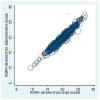An administrative claims measure suitable for profiling hospital performance based on 30-day all-cause readmission rates among patients with acute myocardial infarction
- PMID: 21406673
- PMCID: PMC3350811
- DOI: 10.1161/CIRCOUTCOMES.110.957498
An administrative claims measure suitable for profiling hospital performance based on 30-day all-cause readmission rates among patients with acute myocardial infarction
Abstract
Background: National attention has increasingly focused on readmission as a target for quality improvement. We present the development and validation of a model approved by the National Quality Forum and used by the Centers for Medicare & Medicaid Services for hospital-level public reporting of risk-standardized readmission rates for patients discharged from the hospital after an acute myocardial infarction.
Methods and results: We developed a hierarchical logistic regression model to calculate hospital risk-standardized 30-day all-cause readmission rates for patients hospitalized with acute myocardial infarction. The model was derived using Medicare claims data for a 2006 cohort and validated using claims and medical record data. The unadjusted readmission rate was 18.9%. The final model included 31 variables and had discrimination ranging from 8% observed 30-day readmission rate in the lowest predictive decile to 32% in the highest decile and a C statistic of 0.63. The 25th and 75th percentiles of the risk-standardized readmission rates across 3890 hospitals were 18.6% and 19.1%, with fifth and 95th percentiles of 18.0% and 19.9%, respectively. The odds of all-cause readmission for a hospital 1 SD above average were 1.35 times that of a hospital 1 SD below average. Hospital-level adjusted readmission rates developed using the claims model were similar to rates produced for the same cohort using a medical record model (correlation, 0.98; median difference, 0.02 percentage points).
Conclusions: This claims-based model of hospital risk-standardized readmission rates for patients with acute myocardial infarction produces estimates that are excellent surrogates for those produced from a medical record model.
Conflict of interest statement
Figures



References
-
- Krumholz HM, Wang Y, Chen J, Drye EE, Spertus JA, Ross JS, Curtis JP, Nallamothu BK, Lichtman JH, Havranek EP, Masoudi FA, Radford MJ, Han LF, Rapp MT, Straube BM, Normand SL. Reduction in acute myocardial infarction mortality in the United States: risk-standardized mortality rates from 1995–2006. JAMA. 2009;302:767–773. - PMC - PubMed
-
- Medicare Payment Advisory Commission (MedPAC) [January 4, 2011];Report to Congress: Promoting Greater Efficiency in Medicare. 2007 http://www.medpac.gov/documents/Jun07_EntireReport.pdf.
-
- Krumholz HM, Merrill AR, Schone EM, Schreiner GC, Chen J, Bradley EH, Wang Y, Wang Y-F, Lin Z, Straube BM, Rapp MT, Normand S-LT, Drye EE. Patterns of hospital performance in acute myocardial infarction and heart failure 30-day mortality and readmission. Circ Cardiovasc Qual Outcomes. 2009;2:407–413. - PubMed
-
- Desai MM, Stauffer BD, Feringa HHH, Schreiner GC. Statistical models and patient predictors of readmission for acute myocardial infarction: a systematic review. Circ Cardiovasc Qual Outcomes. 2009;2:500–507. - PubMed
-
- Patient Protection and Affordable Care Act. [January 4, 2011]; Pub L 111–148, 124 STAT 119. http://frwebgate.access.gpo.gov/cgi-bin/getdoc.cgi?dbname=111_cong_publi....
Publication types
MeSH terms
Grants and funding
LinkOut - more resources
Full Text Sources
Medical

